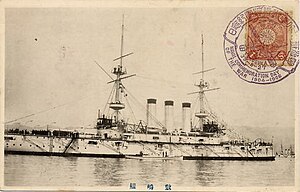
Back Shikishima (Schiff, 1900) German Shikishima Finnish שיקישימה HE Shikishima (nave da battaglia) Italian 敷島 (戦艦) Japanese 시키시마 (전함) Korean Shikishima (1898) Polish Shikishima (couraçado) Portuguese Сикисима (броненосец) Russian Shikishima (thiết giáp hạm Nhật) Vietnamese
 Shikishima in a 1905 postcard
| |
| History | |
|---|---|
| Name | Shikishima |
| Namesake | An old poetic name of Japan |
| Ordered | 1897 |
| Builder | Thames Iron Works, Blackwall, London |
| Laid down | 29 March 1897 |
| Launched | 1 November 1898 |
| Completed | 26 January 1900 |
| Reclassified | 1 April 1923 as transport and training ship |
| Stricken | 1923 |
| Fate | Scrapped, January 1948 |
| General characteristics | |
| Class and type | Shikishima-class pre-dreadnought battleship |
| Displacement | 14,850 long tons (15,090 t) (normal) |
| Length | 438 ft (133.5 m) |
| Beam | 76 ft 6 in (23.3 m) |
| Draught | 27 ft 3 in (8.3 m) |
| Installed power |
|
| Propulsion | 2 shafts, 2 triple-expansion steam engines |
| Speed | 18 knots (33 km/h; 21 mph) |
| Range | 5,000 nmi (9,300 km; 5,800 mi) at 10 knots (19 km/h; 12 mph) |
| Complement | 741 |
| Armament |
|
| Armour |
|
Shikishima (敷島) was the lead ship of her class of two pre-dreadnought battleships built for the Imperial Japanese Navy by British shipyards in the late 1890s. During the Russo-Japanese War of 1904–1905, the ship fought in the Battles of Port Arthur, the Yellow Sea and Tsushima and was lightly damaged in the latter action, although shells prematurely exploded in her main guns in the latter two engagements. Shikishima remained in home waters during World War I. She was reclassified as a coastal defence ship in 1921 and served as a training ship for the rest of her career. The ship was disarmed and hulked in 1923 and finally broken up for scrap in 1948.